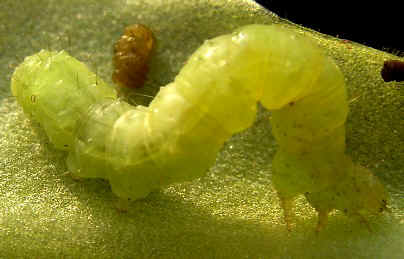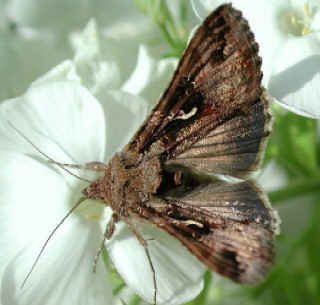
Caterpillar of the Silver Y Moth,
Autographa gamma
(Family : Noctuidae).
Photo : Vic Brown

Autographa gamma
This image in its original context, on the page :
Caterpillar :
- back to Hosts -
Status : Enemy
|
Caterpillar of the Silver Y Moth, Autographa gamma (Family : Noctuidae). Photo : Vic Brown |
Autographa gamma This image in its original context, on the page : |
Description :
- Eggs: greyish white, deposited on the underside of the leaves.
- Larvae : 40 to 45 mm, light green.
- Adult: 40 to 45 mm wingspan. Brownish-yellow fore wings.
Biology and life cycle :
The silver y moth is common in North Africa and in the Mediterranean basin during winter. In summer, it occurs as far north as Scotland and Finland.
- Host plants : the caterpillar attacks the leaves of many cultivated plants so carnivorous plants are no safe.
- Adult : the moths, generally nocturnal, fly very rapidly, either alone or in small groups.The adults fly in the Paris region, France from the end of May to the beginning of June then often also at the end of July.- Larvae : the caterpillar is especially active during the night eating the leaves. During the day, it remains pressed against the underside of the leaves. Larval development lasts about a month.
Damage :
Damage done by a single larvae on a mexican Pinguicula leaf. The damage can be letal if done on the heart of the plant.
Photo : Vic Brown
The larvae eats the leaves of all Pinguicula with a preference for the youngest tender leaves and unfortunately sometimes the heart of the plant. The caterpillar is active during night so you will only note the remained holes during day. The damages of this leave's eater can be distinguish from those of slugs or snails by the lack of the typical dry silvery mucus trail on the ground and on plants, and the small excrements left in place.
Solutions :
You can easily remove the caterpillars by hand, they are especially active during the night. You can also try to catch the caterpillar during the day. It remains pressed against the underside of the leaves. The best thing to do is to prevent the Silver Y Moth from laying its eggs in your greenhouse. You can grow your Pinguicula with some samples of the Drosera binata complex are very effective in catching the flying moth.
Biological fight :
possible but no need, as most of the time, the pest is alone.
Chemical fight :
possible but no need, as most of the time, the pest is alone.
- back to Hosts -